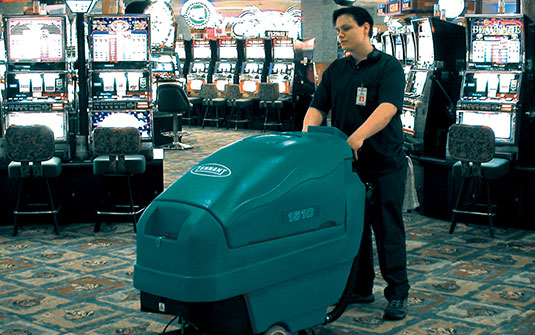Your shopping cart is empty.
4 Things You Should Know About Carpet Extractors
Posted in Staffing & Personnel, Cleaning Solutions, Productivity, Best Practices,

One of the best things about using specialized cleaning equipment is how good it is at the job it’s intended for. Carpet extractors are the perfect example. Their specialized features enable you to deep-clean carpets, rugs, and upholstery in even the most heavily trafficked areas.
If you’re thinking about putting a carpet extractor to work for you, here are a few things you should know.
1. They can extend flooring life.
When it comes to flooring, the main goal of facilities team members and building service contractors is to keep floors clean while extending their life. Carpet extractors help accomplish that all at once. By freeing oily residue from carpet fibers, you can extend its life. And it’s not just residue. The dirt, dust, and debris that can find its way deep into carpet fibers, especially in high-traffic locations, is all damaging to its likelihood of a long life.
2. They have specializations.
Want something mobile? There’s a style. Want something that cleans more deeply? There’s a style. There are two primary types of carpet extractors. The canister/box-and-wand style is maneuverable and great for cleaning smaller or tight areas, and the wand can clean upholstery and hard-to-reach areas. Cool, right? But this style doesn't offer a rotating beater brush that extracts more dirt from carpets. For an agitating carpet brush feature, you'll need to opt for the self-contained extractor, which agitates more dirt from carpets and cleans larger areas quicker. Self-contained extractors are generally walk-behind machines with more speed at the expense of some of the portability.



3. They have different motor types.
Carpet extractors generally come with either two-stage or three-stage vacuum motors. Three-stage motors are better for extraction than two-stage motors primarily because of increased water lift. Think about how extractors operate — first, the machine puts down liquid to clean the carpet, and then it vacuums it back up. So, increased lift means less of that water stays saturated in the carpet, which also means less time until the carpet is dry and can be opened up to foot traffic — usually a key need in most facilities. You have a choice about what works best for you and the type of facility you manage or own. Three-stage motors and their increased lift also generally come with two power cords and additional operation requirements.
4. They work well with others.
You can get better performance from your carpet extractor by pairing it with other equipment. For instance, we were just mentioning water lift. Regardless of how much lift you get from your two- or three-stage motor, your freshly cleaned carpet will still have some residual moisture. An air mover is a perfect partner to help dry carpet faster after using an extractor. The faster your carpet dries, the better. And there’s a step you can take before extracting that helps, too: Vacuuming with a powerful vacuum. It’s easy to fall into the trap of thinking that you don’t need to do much prep — after all, you’re about to use a serious carpet extractor on the carpet. But all the dirt that you remove before using the extractor reduces its overall workload and increases the chance of a deeper clean on the remaining mess.
When it comes to removing messes from carpet, keeping it clean and extending its life, a carpet extractor is a great tool to have.
RELATED LINKS




